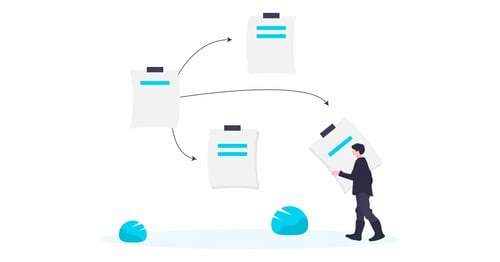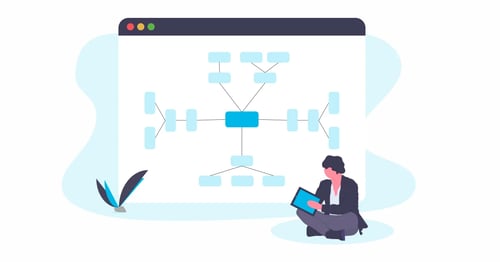Legal Project Management: 10 Best Practices for In-house Teams
 In recent years, legal project management has become one of the most important skills for in-house legal teams to acquire. As law teams have increasingly been stepping up as operations managers, developing the right processes has become a central concern within many organizations.
In recent years, legal project management has become one of the most important skills for in-house legal teams to acquire. As law teams have increasingly been stepping up as operations managers, developing the right processes has become a central concern within many organizations.
In-house lawyers occupy a hybrid position where the traditional concerns of a lawyer merge with additional business challenges like working in a team and managing other employees. The project life cycle thus has a range of unique obstacles that private practices don’t encounter in the same way.
Even though failure isn’t an option for most enterprises, a large number of companies are falling short of their objectives. Research has indicated that only 64 percent of projects meet their goals.In this article, we’re going to look at the 10 best practices in-house teams should be using to manage their projects more efficiently. By adhering to some fundamental best practices, you can help dramatically reduce the chance of a project failing and smoothen internal communication.
Clarify the objectives and scope early on

The first thing you need to do is set out the objectives and scope of the project with your team and stakeholders. From an in-house perspective, your employer is your client, so you want to make sure you know who will be overseeing the project and what objectives they are working to achieve.
Writing up a document or an email with a project outline will help to give you a frame of reference throughout the project. Having a goal to refer to during the project will help to keep your team aligned and avoid any misunderstandings about the direction of the work ahead.
Set up a project kick-off meeting

Once all the key stakeholders have seen and agreed to the details shown in the outline it is time to schedule a kick-off meeting to explain to the internal team and any external counsel what the aims of the project are. The objective at this stage is to make sure that everyone in the department understands their role in delivering the project.
The list of things discussed should be; team member roles, the timeline of the project, a defined change management process, defining who is in charge of managing the project, and obstacles to avoid. There should also be time allocated for questions so that employees can ask about anything they don’t know.
Determine who is in charge of financial management

Managing your finances can be just as important within a company as it is in a private practice environment. If the legal department is responsible for managing project finances in your organization, then you should appoint a member of staff to oversee spending throughout the project.
Appointing a financial management lead or finding an employee responsible for financial management will ensure you have someone to oversee financial concerns throughout the project. The employee will need to consider things such as budget and monitor spending throughout the project to make sure that it is economically viable.
Regularly communicate with your team and stakeholders

Projects comprise a range of deliverables, and stakeholders will have specific expectations of each outcome. Sending them updates when each deliverable is through can help to check up on the overall progression of the project. While you should have a broad outline from the beginning of the project, it is essential to follow-up to check that you’re on track.
At the start of the project, ask the stakeholders how they’d like you to communicate. Some individuals will prefer that you send detailed reports, whereas others will prefer brief email updates. Finding out what the client prefers will make sure that they don’t miss out on any last-minute updates. You don’t want to send out a conveyor belt of email updates if the stakeholder isn’t going to read them.
Define a change management process

Even with an iron-clad plan, changes are inevitable throughout the project lifecycle. Setting out a change management process will help the legal department to stay flexible if the project switches direction. You will need to appoint a change management lead to approve changes throughout the project and ensure that you’re still moving in the right direction.
Some changes that you can expect to encounter include an increase in scope or budget. As part of your process you will want to allocate who will communicate with your department, stakeholders, and any external counsel. Designing a change management process will make sure that you aren’t left scratching your head if a project changes at the drop of a hat!
Create a timeline of the project lifecycle and milestones

Never-ending projects are every lawyer’s worst nightmare. Creating a project timeline at the start of a project improves your organization and lets you know when you can expect to finish the deliverables. When designing the timeframe you want to break the lifecycle down into milestones so you can work through the project in bite-sized chunks.
Once the timeline has been created, you can share it with the rest of the team. Having milestones to check up on also allows you to measure how far the project is coming along without missing any of the smaller details.
Draw up a communication plan

Communication is an integral component of any legal project and having guidelines for employee correspondence simplifies collaboration. How easily team members can communicate with each other will determine the success or failure of the project. If there is no set process, then you are going to end up with ad-hoc communications when working on project deliverables.
As part of the communication plan, you should draw up a schedule for regular meetings, a framework for communicating between meetings and use report templates to pass on relevant information to colleagues without having to draw documents from scratch. The plan will be instrumental in making sure the team stays aligned on throughout the process.
Use legal project management software

Having the right tools to manage a project is another fundamental component of overseeing an operation. A digital project management tool is essential for modern enterprises monitoring lots of concurrent contracts. Hive has found that 77 percent of high performing projects use project management software. These tools are valuable because they centralize document access.
In addition, these tools enable the user to create contract templates hosted in the cloud. Having templates hosted in the cloud is useful because it means that the user can fill out and share contracts online. A simple document management solution eliminates the hassle of trying to oversee project deliverables manually.
Design a quality assurance process

Quality assurance is integral for making sure that your project deliverables are up to scratch. The quality assurance process should be about designing an end product that satisfies your team and stakeholders. Without a transparent process, you run the risk of taking a project in the wrong direction or delivering poor work.
Every component of a project should be checked by another individual in the team to make sure that there aren’t any errors that they could have missed. Remember that a quality assurance process can be the difference between a satisfactory project and an exceptional one.
Review projects after the fact

After completing the project, the legal department and the stakeholders should review the outcomes. The review should measure the quality of the results and whether the deliverables met the stakeholder’s expectations. For example, if the communication was a little lax, then members of the client can provide you with feedback to improve.
Project feedback is a goldmine of insights and can be used to enhance the management process for future projects. Don’t be hesitant to ask where you could do better, because all information will be useful when it comes to serving the next client. Try to recognize what went well just as much as things that could be improved.
Remember: legal project management is about communication

Legal project management is all about communication. A mix of communication internally and externally is required to deliver a project successfully. Working to understand the objectives of the client and communicating those with your employees will give you the strongest base to start from.
Once employees understand the expectations of the stakeholders, they know what they should be looking to achieve. Having the tools and processes in place to manage deliverables serves to remove any unnecessary ambiguity. Designing processes in advance pays dividends because it eliminates uncertainty over what should be done in a particular scenario.
In-house project management comes down to making sure employees on the ground know how to execute the stakeholder’s aims. Open dialogue between you and your stakeholders will ensure you deliver a premium end product.
 By
By


